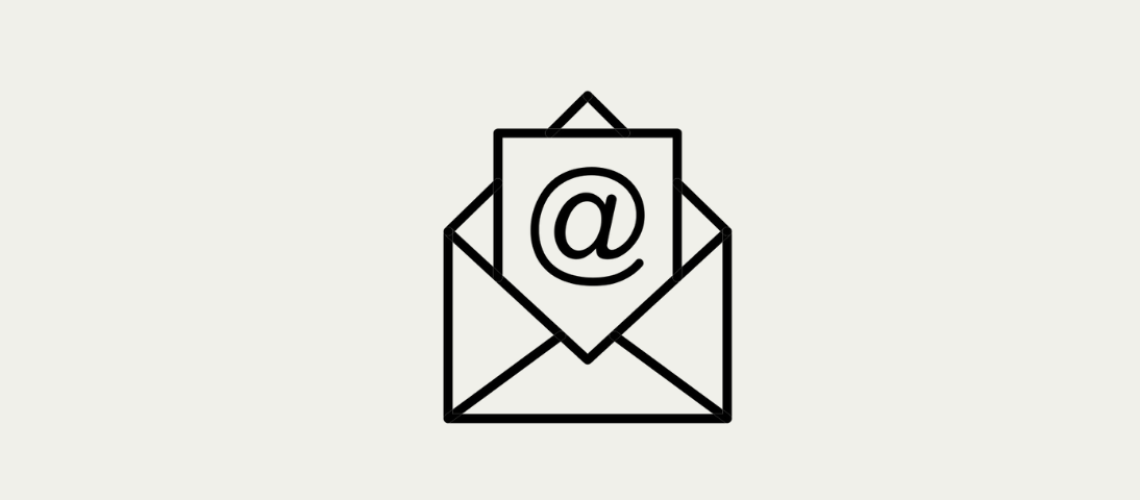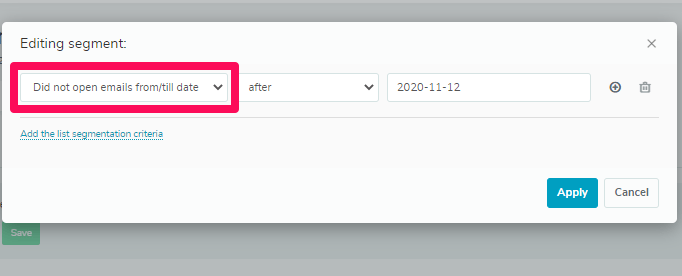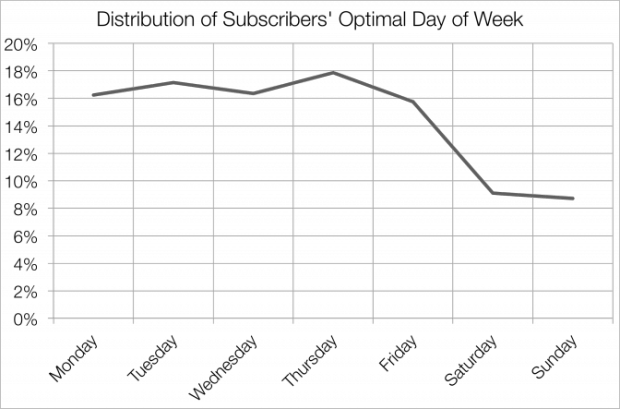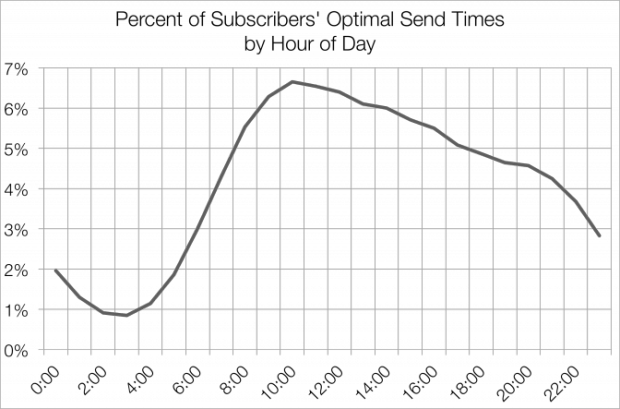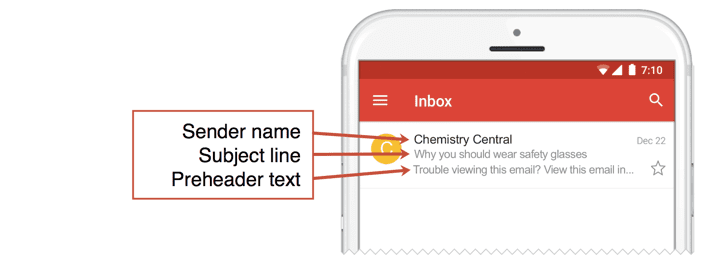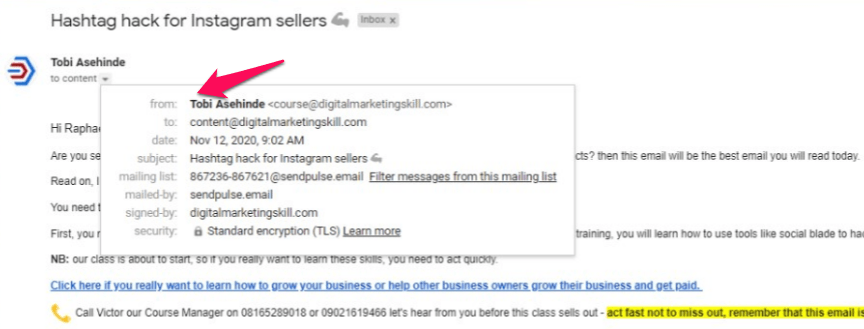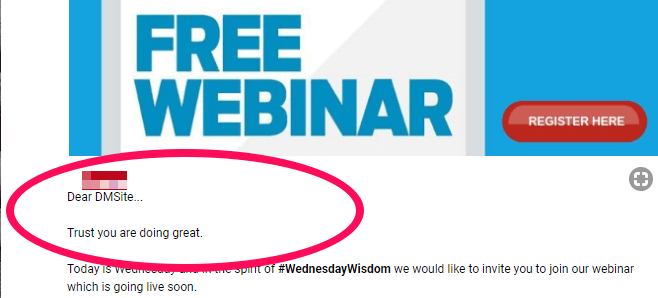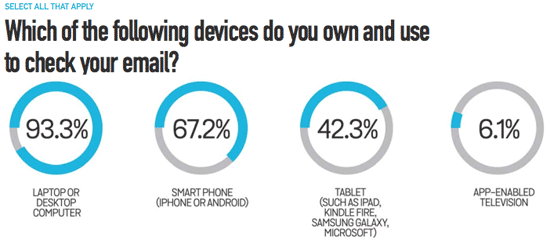What if I tell you that if you continue to use the strategies you know or strategies you’ve learned from unproductive blog posts, you’ll never get up to 10% email open rates for any of your campaign?
I’m certain about this because right now you might be still be making these mistakes and using strategies that you think might get you results:
- you’re optimizing your email headlines with words THAT ARE NOT as powerful as possible in marketing
- You have not cultured your leads to “expect your emails” so they are not looking forward to your emails
- worst of all, your emails are going to promotion inbox and you haven’t rectified the issues of emails going to promotion inbox and updates inbox
With these issues and more that I will highlight in this blog post, you’ll never get up to a 10% email open rate. But the good thing is that the strategies to get up to 45% email open rates overtime are listed below, so read on and I will show you these strategies.
Email marketing is one of the most powerful tools in your arsenal, but it only works if your recipients open the emails you send them.
Every additional email open means more potential sales and revenue, and even a tiny increase in your open rates can make a huge difference for your business.
According to data by Smart Insights, most industries average a 20-30% open rate.
The number of emails sent is growing rapidly. Target Internet forecasts growth averaging 109 billion in 2015 to 162 billion in 2020
Oh, and that’s 140 billion…a day.
Yes, you read that right. That’s 20 emails each day for every person on the planet!
At the same time, according to eMarketer.com, open rates continue to decline.
Yet, email remains at the core of most sales and marketing strategies. Strong email lists are, after all, a more secure asset than website traffic (you’re not totally in control of how much traffic your website can get, but do have full control over your email list).
And this is one of the many reasons why our digital marketing training is most preferred due to the very immersive and practical email marketing class that teaches you how to use email service providers (software) like GetResponse, build email lists with landing page like Instapage, and a content marketing class that teaches you how to write compelling and sellable copy to 10x your conversions.
Click here to learn more about the training.
Get 50% Discount to Master ALL Aspects of Digital Marketing That Can Earn You $2,500 - $5,000 a month (Even if you are a complete beginner!)
Our students that intentionally implement what they learn from our digital marketing course make back the entire course fee within a single month or more after completing our course because our course gives them many income generating options with unlimited earning potential with no age or location barrier. The best part is no technical skills are required.
An opportunity to change your lifestyle and make money working from anywhere in the world. The results our students get from our digital marketing course prove this could be applied to any market or country and that it is designed for any skill level and work background.
*By signing up, you agree to our privacy policy and terms of service.
While that statistic might be comforting to you if you’re in that 20-30% range, I guarantee you can improve your open rate with a few simple email open rate hacks.
So how can a salesperson increase their email open rates over time in a world where inboxes are already brimming over?
I’ve outlined 10 crazy hacks that can double your email open rates fast.
But first, some basics…
What is an Email Open Rate?
Email open rate is the percentage of the total number of subscribers who opened an email campaign.
[bctt tweet=”Email open rate is the percentage of the total number of subscribers who opened an email campaign. ” username=”dmsinstitute”]
These rates can vary depending on the subject line and the relevancy of the subject matter for subscribers, but according to Campaign Monitor, a healthy open rate is typically in the 20-40% range.
When next you send out an email, look out for the mean number and percentage of your subscribers who opened that particular email.
There are a lot of factors that can affect email open rates, and these can be any or a combination of the following:
- your email headline don’t encourage open rate
- the quality of your lead
- emails going to promotion inbox
Email Open Rates Over the Years
Wait, but isn’t email marketing dead?
There has been a lot of debate over the effectiveness of emails in marketing.
Many people believe that emails are a dying art and are no longer effective, however, we don’t agree and the statistics don’t agree either.
One important thing to take note of is the popularity of emails throughout the years. This is not only a factor to consider when determining the success of your email campaign but it is also interesting to see just how effective email marketing has been through the years.
[bctt tweet=”Email marketing has been one of the most popular marketing methods for years, and since 2006 the open rates for emails has been fairly consistent. ” username=”dmsinstitute”]
In 2006, it was reported that over 20 percent of emails were opened. This number remained consistent until around 2013 when email open rates spiked to nearly 30 percent. This may have been due to the fact that more and more people were getting smartphones and syncing up their emails.
In 2016, it was reported that email open rates dropped back down to just under 25 percent. This proves that for the last 10 years, email is still stocking up to be an effective marketing method.
Even though we now have the emergence of Instagram and Snapchat at our disposal, it seems that email marketing is still standing the test of time.
Want to double your email open rates? These hacks will help you know how to increase your email open rates in just one week of applying them.
Let’s dive in!
#1: Keep Your Mailing List Fresh
Do your subscribers still want to hear from you?
You’ve probably heard the advice that it’s important to email your subscribers on a consistent basis so your list doesn’t go stale.
But even so, over time, email subscribers can still go stale. Some people may have changed email accounts, or maybe they just aren’t interested in your brand anymore.
So to keep your list fresh and filled with engaged subscribers, it’s a good idea to periodically remove inactive subscribers.
An inactive subscriber could be anyone who has not engaged with any email in the past 6 months or more.
But before you get rid of them, try sending a last-ditch-effort email to try to re-engage your inactive subscribers.
You can also start by adding tags to your subscribers based on behavior, such as purchase behavior. So when someone becomes a paying customer, you send them different types of emails than you would send to someone who has not purchased anything yet.
You could even send different emails based on the specific products they purchased.
You can also segment your lists based on demographics (such as location), or interests. How did they get on your email list in the first place?
If they downloaded one of your leads magnet on a particular topic, create a segment of those people so you can send them more emails on that specific topic.
Once you have these segments, it is so much easier to know what subject lines and messages to write that will entice them to open and engage with your email marketing campaigns.
This is a known hack on optimizing your email open rates since email service providers depend on the relevancy of your emails by looking at how often your email subscribers, this is why most emails might be regarded as irrelevant if there are so many subscribers who don’t open your emails.
#2: Avoid Spam Filters
Spam filters have gotten more sophisticated in the past several years, but they’re still not perfect. Your emails, even your best emails, can still get caught in the dreaded spam folder, never to see the light of day.
If you want to maximize the reach of your email marketing campaigns, you’ll need to do everything possible in order to avoid being flagged as spam.
Here are some best practices to keep your emails from falling into spam folders:
- Make sure all recipients have actually opted-in to receiving your emails that are by giving you their permission to send the emails.
- Send your campaign from a good IP address; that is, an IP address that hasn’t been used by someone else who has sent spam in the past.
- Send through verified domains.
- Keep any code clean.
- Use merge tags to personalize the “To:” field of your campaign. This would send the emails with the recipient’s name.
- Show subscribers how to whitelist your emails, and ask them to add you to their address book.
- Avoid the excessive use of “sales” language (these are spam trigger words like “buy”, “bonus”, “free”, “discount”, “cash”, guarantee, etc).
- Don’t “bait-and-switch” by using deceptive subject lines.
- Include your location and contact details at the footer in compliance with the CAN-SPAM Act.
- Include an easy way for subscribers to unsubscribe from your emails.
- reduce the rate at which you repeat certain words.
#3: Perfect Your Send Timing
Timing can have a huge effect on whether or not your subscribers open your emails, so think carefully about what time and day you send your emails out.
You won’t be able to figure out the perfect time immediately but perform some A/B tests to identify which timeframes seem to perform best and explore those in future campaigns.
Well, MailChimp’s data says that, in general, the best time of the week to send emails is on weekdays versus weekends. No single day won hand’s down.
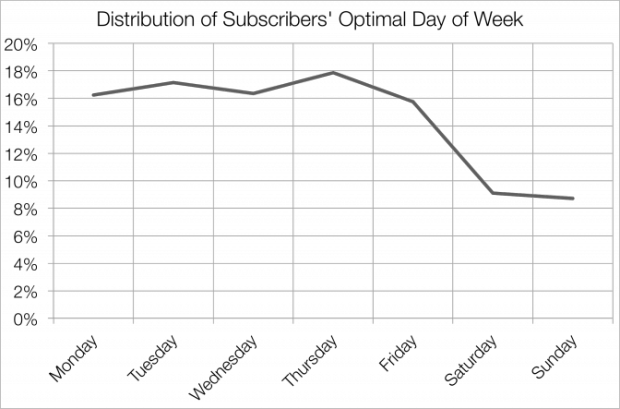
They also found that, in general, the optimal time of day to send emails is at 10 am in the recipients’ own time zone.
However, the bottom line on email send time is this:
Imagine a day in the life of your typical audience according to the customer avatar that you have designed.
What are they doing in the morning, afternoon, and evening? What does their workday look like? How late do they stay up at night? How early do they rise in the morning?
[bctt tweet=”What are they doing in the morning, afternoon, and evening? What does their workday look like? How late do they stay up at night? How early do they rise in the morning?” username=”dmsinstitute”]
All of these questions will help you decide on the best time to send your emails.
#4: Make Your Subject Line Stand Out
When it comes to email open rates, your subject lines are everything. Your job is to make your subject lines stand out.
[bctt tweet=”When it comes to email open rates, your subject lines are everything. Your job is to make your subject lines stand out.” username=”dmsinstitute”]
Companies have used email marketing for years, often copying the same subject line formulas. As a result, these common subject lines are often filtered out as white noise.
To break away from the competition, you’ll have to get more creative with your subject lines.
Here are some tips for crafting creative subject lines:
- Entice curiosity, but don’t be too clever. You want to make them curious enough to open, but without being so cryptic that the subscriber hasn’t a clue as to what you’re talking about.
- Insert numbers for a much higher chance to get a good email open rates. Numerical figures encourage clicks. Take for instance, “10 best hacks for email deliverability”, people know there are more hacks and strategies, but they would love to know why you chose your best 10.
- Use conversational tone.
- Speak in the language and style that your subscribers use themselves, especially when talking with their friends.
- Make use of emojis
Aside these strategies, one of the most effective strategy in optimizing your email open rates benchmark is to personalize the email headline using the subscribers’ names.
NB: every email marketing platform has its personalization code. For Sendpulse, it is {Name}}. For MailChimp it is *|FNAME|*.
You can get some more tips and practice exhaustively them when you register for our digital marketing training where you would learn the ABC of email marketing and go from novice to expert in weeks.
#5: Don’t Forget your Pre-header Text
When you see an email in your inbox, the subject line and accompanying text that fill up that line are known as the preheader, and it helps in your email open rates overtime.
The actual length varies by the email client, but as an example, Gmail gives you 100 characters to work with.
In other words, if your subject line is particularly long, you can forget about any preview text from the email showing up.
[bctt tweet=”To use this to your advantage, first, make sure that you’re keeping your subject line at 50 characters maximum. This gives you 50 characters to make a compelling case for the viewer to open your email.” username=”dmsinstitute”]
Make sure the subject line flows logically into the first lines of the email, too.
You want everything to tell a story and prompt your reader to want to know more.
Use calls to action to help trigger this response.
#6: Fix your ‘From Name’
Do you know what you used as the “from name” in your last email campaign? What about the “from email address”?
The from fields let readers know who an email is coming from.
If you’re not thinking carefully about the information you put into these fields, you could be making it difficult for people to recognize your email when it lands in their inbox.
People are skeptical of emails when they don’t know the sender; they could be less likely to open and more likely mark your email as spam.
Also, it’s important to note that this is one of the required boxes to tick for most email marketing platforms since they don’t encourage spam on their platform.
This is how it will appear in your subscribers’ email inbox.
#7: Write to Just One Person
When you draft your subject line and message content, it’s natural to think of the thousands of people who are about to receive it.
However, it’s far more effective to write as if speaking to an individual person, with a personal subject line and a personalized message.
In order to write this way, you’ll have to really know your buyer persona. You need to understand their problems, their desires, their values, their likes, and their dislikes.
If you are having trouble with this, send out an email asking for a quick five-minute chat. On the call, you can ask questions that will help you understand what your subscribers’ needs are, and how they think.
Spending a day or two talking with your subscribers will be time well spent because it will help you immensely: not only with your messaging but also with creating or improving your products and services.
#8: Write Like a Friend
When writing your emails, you’ll need to put your corporate hat to the side and write like a friend. This is the only way to really appeal to your subscribers and get them to open your emails.
For example, a corporate phrase like, “We’re offering savings to our customers!” comes off as distant and stuffy.
A more friendly alternative could be something like, “you’ve gotta check out this deal…”
That makes the email seem a whole lot more personal and makes it less likely that your recipients will simply delete your message and move on.
Here’s another example of a friendly copy from one of our emails to our digital marketing training alumni list:
Remember: in this age of information, everyone is looking for a reason to ignore your emails.
They aren’t looking for a reason to read them. But if you appeal to them on a personal level, you’ll stand a better chance of getting an open.
#9: Drive Value…Every Time
There is nothing that boosts email open rates overtime as valuable contents.
Fact, even if your emails land on promotion inbox, if your subscribers are expecting your emails, they would dig it up from there, read, click and achieve your emails, and overtime, email services providers would take a hint and boost your deliverability.
The content inside your email is actually really important for open rates because if your subscribers are happy with your content, they are more likely to open your emails in the future.
They may even begin to eagerly anticipate your emails.
Conversely, if a subscriber is displeased with what they got in your email, they probably aren’t going to open your emails again, and they may even unsubscribe.
[bctt tweet=”So how do you make sure your subscribers are happy with your email content? Simple: make it awesome.” username=”dmsinstitute”]
Link to incredibly valuable resources, like a free eBook, an epic blog post, or a webinar.
The key is to make sure that you aren’t sending emails just to send emails. Every single time you email your list, you need to deliver something of real value. The higher the value of every email you write, the more loyal your subscribers will become, and your open rates will increase.
#10: Don’t Forget Your Mobile Users
According to eMailmonday, mobile email accounts for 15-70% of all email opens (depending on your target audience, product, and email type).
And, according to BlueHornet, 67.2% of consumers use a smartphone to check their email.
This means you simply can’t afford to ignore your mobile users –you have to appeal to them.
The obvious tip here is to make sure your email is mobile-friendly (with responsive formatting
and loadable media), but also consider the fact that mobile screens are smaller, so long subject lines won’t be viewable on mobile devices.
Aside from keeping your subject lines concise, here are some more tips for appealing to mobile users:
- Keep the formatting simple (single-column), under 600px wide.
- Use a larger font– small fonts are difficult to read on mobile.
- Don’t assume images are being displayed (Android turns images off by default). Make sure it looks good without them.
- Use smaller images to reduce load time.
- Use a large call-to-action button– larger buttons are easier to tap with a thumb.
- Don’t place two links next to, or on top of one another. That way, the user would tap the wrong one by accident.
What is an average email open rate?
A good open rate should be emails with open rates of up to 15-25% on average. What this means to your number and business is that, if you have an email list of 100,000 subscribers, and you average an email open rate of 25%, then 25,000 people could be considered to have opened your email.
If 1% of this number buy your products everyday, then you’re in for a real business growth.
Now imagine what you could be making if your email open rates are hitting up to 40% on average?
Though email open rates by industry varies as some industry have been notably strong in averaging a good email open rate.
For instance, according to Campaign Monitor, Goverment organizations and non profit organizations have the best email open rates. As of 2020, Government organizations average an email operate rate of 30.5%, while non-profit organization hit up to 25.0% open rates.
Conclusion
While I don’t suggest you attempt to mash all 9 of these email hacks into one big experiment, I do suggest that you start testing what you’ve learned.
First and foremost, make sure that your email content is locked down. If you’re not getting people to read your emails, then there’s no point in sending.
After that, give some thought to when you send your emails and build out a schedule to test various days and times.
And lastly, when you’re crafting your preheader text, always keep a 100-character count in mind and spread that evenly across the subject line and the first line of email copy.
At the end of the day though, these hacks are all taking advantage of how the human brain works. And while that might be enough to capture your reader’s attention in 3–4 seconds, you are still a human and they are too.
All of these and more are part of what you get when you attend our digital marketing training. Plus, you also enjoy 1-year support to help you get a perfect hang of these actions and redirect you whenever you derail from the process.

